Posts Tagged ‘veterinarians Glen Carbon’
Tips and Tricks For Grooming Your Pet
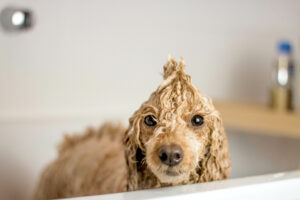
Part of taking care of your pet is regular grooming efforts to keep their coat healthy and your pet comfortable. These tips will help you stay on top of their grooming and keep your pet happy and healthy.
First, be sure to regularly brush your pet’s coat to prevent matting. Especially with long-haired animals. Your pet needs regular brushing regardless of the breed to keep its coat shiny and healthy. The amount of brushing depends on coat length and texture. Longhaired breeds will need more frequent brushing of at least once a week if not every other day. Short-haired breeds like greyhounds or Labradors may need a good brushing only every other week. Matting can cause pain for your pet. This will lead to licking or biting, causing skin irritation which can then lead to skin infections. Be sure to brush your pet regularly to keep their coat healthy.
Second, many pet owners choose to have a groomer take care of their pet’s hair care. That said, if you proceed carefully, you can trim overgrown hair around your pet’s eyes or pays in between professional grooming appointments. Trimming the hair around your pet’s eyes can prevent overgrown hair from blocking its vision and rubbing against and damaging its eyes. When trimming, make sure your pet is calm and lying down, preferably. Move slowly and calmly and use extra caution with scissors. Make sure to reward their calmness with a treat after they are finished.
Third, trimming your pet’s nails will keep them from experiencing discomfort from overly long nails. There are many different tools to do so, and you may have some trial and error until you find what works best. There are plenty of resources found online for guidance on your specific pet and how to trim its nails.
When grooming your pet, be sure to check their ears for ear infections. Ear infections can be painful, so if you notice any inflammation, odd smells, shaking or scratching, discharge, or pain upon touch. If you notice any of these signs during your regular grooming, take your pet to the vet for a checkup.
Grooming your pet is part of their regular care of them such as feeding them and providing them with exercise. With these tips, you can be more prepared for helping your pet take care of itself. Of course, with any questions, feel free to contact Dr. Olsen at Olsen Veterinary Clinic at 618-656-5868.
CBD For Your Dog: What You Need To Know
 CBD can work wonders for dogs in oils or dog treats. CBD can provide the same benefits for dogs as medical marijuana for humans who experience seizures, extreme pain, anxiety, and cancer. CBD is not what you may traditionally view as weed. CBD is not psychoactive, unlike its more famous counterpart, THC (tetrahydrocannabinol). CBD is one of over 80 different chemical compounds called “cannabinoids” derived from the marijuana plant. Instead, CBD shares important metabolic pathways with a class of drugs called NSAIDs (non-steroidal anti-inflammatory drugs) like ibuprofen and Rimadyl. These pathways control many processes in the body, from inflammatory responses to blood clotting. Never give dogs straight marijuana or any product containing THC, the primary psychoactive component of marijuana. However, CBD-based products can substantially improve your dog’s quality of life when used in conjunction with other therapies.
CBD can work wonders for dogs in oils or dog treats. CBD can provide the same benefits for dogs as medical marijuana for humans who experience seizures, extreme pain, anxiety, and cancer. CBD is not what you may traditionally view as weed. CBD is not psychoactive, unlike its more famous counterpart, THC (tetrahydrocannabinol). CBD is one of over 80 different chemical compounds called “cannabinoids” derived from the marijuana plant. Instead, CBD shares important metabolic pathways with a class of drugs called NSAIDs (non-steroidal anti-inflammatory drugs) like ibuprofen and Rimadyl. These pathways control many processes in the body, from inflammatory responses to blood clotting. Never give dogs straight marijuana or any product containing THC, the primary psychoactive component of marijuana. However, CBD-based products can substantially improve your dog’s quality of life when used in conjunction with other therapies.
CBD can help with many ailments your dog may experience such as pain management, arthritis, anxiety, seizures, and even cancer. Because CBD shares the same metabolic pathways as anti-inflammatory drugs, it can help with inflammatory conditions. Anything that ends in “-itis” is an inflammatory condition. This includes osteoarthritis (arthritis for short). 25% of dogs will be diagnosed with arthritis in their lifetime. By some estimates, as many as 60% of dogs exhibit some degree of the disease. CBD can provide relief for dogs that may be experiencing pain.
With any treatment, there are potential risks. Overall, CBD itself seems to be incredibly safe for both dogs and cats. However, it has been found that when given at the recommended doses, CBD does cause an elevation in an important liver value on bloodwork called alkaline phosphatase (ALP). It is too early in its research to see if the elevation in this liver value has any medical significance. It could signify that CBD causes irritation or damage to the liver. Alternatively, it could be an artificial finding in which the drug interferes with the way the lab measures the liver value. It is simply too early to know for sure. There are anecdotal reports of dogs becoming somewhat sleepy or sedate if they receive a large dose of CBD, but these effects resolve independently with time. Moreover, CBD doesn’t appear to have any drug interactions when given to a dog on an anti-inflammatory drug like Rimadyl. However, there is a theoretical risk of drug interaction, as with any other medication, so it is essential to consult with your veterinarian before treating your dog with CBD.
CBD can be administered in topical treatments; however, it is most often administered orally to dogs. The correct dosage is imperative. Studies on using CBD for dogs with arthritis or seizures generally use a dose between 2-8 mg/kg, with most papers erring on the lower side of that estimate. This is about 1-2 milligrams per pound of body weight, twice daily. This dosage has been found to be safe and effective for use with arthritis and seizures. Additional research is needed to evaluate the differences in CBD dosages for other conditions.
CBD can provide benefits for your dog that may be experiencing pain or anxiety. However, the correct dosage is imperative. If you have any questions, feel free to contact Dr. Olsen at Olsen Veterinary Clinic at 618-656-5868.
Dr. Olsen’s Breed Spotlight: The Peterbald Cat

The Peterbald cat is a loyal and affectionate feline, known for being “dog-like”. They are very friendly, playful, energetic, and smart. The Peterbald is a descendent of the Don Sphynx cat, still bearing some of its qualities like its varying amount of fur, dexterous front paws, big ears, and wrinkly skin. The other feline in a Peterbald cat is the Oriental Shorthair cat. The Peterbald still carries its long and lithe body shape and oblong head shape from them. However, unique to a Peterbald is their long front toes with webbing. It allows them to hold and manipulate toys, unlike many other cats.
The Peterbald’s fur varies from a velvety, fuzzy fur to a completely hairless cat. There is even a type that doesn’t even have whiskers or eyebrows, making their skin feel sticky to the touch. Also interesting is that Peterbald’s fur changes throughout their life. This means that if a Peterbald has one of these coats at birth, it can change significantly during their first two years of life, and the hair can be altered, gained, or lost.
The care of Peterbald cats varies based on their coat. If they have a thin fur coat or no hair at all, they require weekly bathing and wipe downs to keep their skin free of harmful oils. Since Peterbald cats can have very thin coats, they need to be kept as inside cats. Moreover, many Peterbald cats can sunburn, have sensitivity to extreme temperatures, and can be easily injured when playing with other cats or children. But given proper care, these cats are relatively low maintenance and have very few associated breed-health issues.
If you are looking to adopt a Peterbald, know that these cats are still somewhat rare, so acquiring one is not an easy feat. Be sure to check with animal shelters, rescue groups, and reputable breeders to see if a Peterbald is needing a forever home. Since they are often not readily available, it can be difficult to find a Peterbald kitten. Important to note is that hairless cats are often sold for higher prices.
If you have any questions, feel free to contact Dr. Olsen at Olsen Veterinary Clinic at 618-656-5868!
Seatbelts For Dogs – What You Need To Know
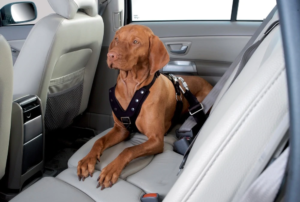 When you get into the car, you think about bucking yourself up. Your dog is most likely not getting their own seatbelt. In fact, 84 percent of pet owners don’t restrain their dogs on car trips according to a survey done by AAA. Even if you think you have the calmest dog in the world, your dog does need a seat belt. It helps keep them and the driver safe.
When you get into the car, you think about bucking yourself up. Your dog is most likely not getting their own seatbelt. In fact, 84 percent of pet owners don’t restrain their dogs on car trips according to a survey done by AAA. Even if you think you have the calmest dog in the world, your dog does need a seat belt. It helps keep them and the driver safe.
When dogs are restrained or contained in the car, they can’t distract the driver as much. According to the CDC, nine people are killed and 1,000 more injured because they were distracted while driving every day. While cell phones are the biggest distracter, your pet can be a major attention grabber too. Roughly two out of three dog owners admit to being distracted by their pup in the car. If you are in an accident, a dog without a seatbelt can turn into a deadly projectile. A ten-pound dog exerts 500 pounds of force during a 50-mph collision while a 60-pound dog becomes a 2,700-pound projectile at 35-mph. Overall, a dog without a seatbelt can cause serious damage in an accident.
Some states require pet restraint laws. So far, only three have laws that require your dog to buckle up in the car, Rhode Island, Hawaii, and New Jersey. Others forbid pets from riding in the back of pick-up trucks or on a driver’s lap. While Illinois does not have any specific pet restraint laws, you can still get a ticket for distracted driving if you get pulled over and your dog is not restrained. The safest place for dogs is in a carrier or harness in the back seat. Just as an airbag can damage a child, the same is for your pet. To get your pet used to a harness, start slowly with five-minute trips, and then expand to ten- and 15-minute rides. Eventually your dog will get used to it. During the outing, be sure to give your dog plenty of praise and a treat after the run.
When you get into the car, you think about bucking yourself up. Your dog is most likely not getting their own seatbelt. In fact, 84 percent of pet owners don’t restrain their dogs on car trips according to a survey done by AAA. Even if you think you have the calmest dog in the world, your dog does need a seat belt. It helps keep them and the driver safe. When dogs are restrained or contained in the car, they can’t distract the driver as much. According to the CDC, nine people are killed and 1,000 more injured because they were distracted while driving every day. While cell phones are the biggest distracter, your pet can be a major attention grabber too. Roughly two out of three dog owners admit to being distracted by their pup in the car.
If you are in an accident, a dog without a seatbelt can turn into a deadly projectile. A ten-pound dog exerts 500 pounds of force during a 50-mph collision while a 60-pound dog becomes a 2,700-pound projectile at 35-mph. Overall, a dog without a seatbelt can cause serious damage in an accident.
Some states require pet restraint laws. So far, only three have laws that require your dog to buckle up in the car, Rhode Island, Hawaii, and New Jersey. Others forbid pets from riding in the back of pick-up trucks or on a driver’s lap. While Illinois does not have any specific pet restraint laws, you can still get a ticket for distracted driving if you get pulled over and your dog is not restrained.
The safest place for dogs is in a carrier or harness in the back seat. Just as an airbag can damage a child, the same is for your pet. To get your pet used to a harness, start slowly with five-minute trips, and then expand to ten- and 15-minute rides. Eventually your dog will get used to it. During the outing, be sure to give your dog plenty of praise and a treat after the run.
It may be tempting to have your dog ride shotgun with you, but for their safety and yours, keep them buckled up in the back. With any questions, feel free to contact Dr. Olsen at Olsen Veterinary Clinic at 618-656-5868!
Holiday Pet Gift Guide – 2021
 The holidays are a time for giving, and you can’t forget about your pets or a pet-lover in your life. I’ve assembled a list of the best pet gifts around to show your furry loved ones you care and help them participate in the holiday spirit.
The holidays are a time for giving, and you can’t forget about your pets or a pet-lover in your life. I’ve assembled a list of the best pet gifts around to show your furry loved ones you care and help them participate in the holiday spirit.
The easiest gift is that of more toys for your pet. You can get new toys you think they would like or replace the favorites that always seem to go missing. Here are some cute toy options that your pet would love. Here is a cute Christmas pickle dog toy. Here is a winter rope dog toy. Here is a cute snowman cat toy. Here is a catnip-based reindeer cat toy.
More practical, you could get new essentials like water or food bowls or new leashes. Items like these are always welcome since they get used daily by pets. Here is a nice modern option that is useful and still looks nice in your home. Here is the link.
For a more unique gift, you could get a pet DNA kit to see what their history is as an animal. For some kits, you can learn about their preferences as an individual animal. An example cat DNA test is linked here. Here is a dog DNA test. Here is a pet food and environmental intolerance test to see what bothers your pet.
You could also get your pet a nice jacket to keep them extra warm in the cold winter months. An example one for your dog is linked here. Maybe you’d like a more fun outfit to wear on the special holiday. An example is linked here.
Perhaps your dog likes to stick their head out the window. Some protective goggles for their eyes can be found linked here.
For the pet-lover in your life, you could get them a personalized pin for them to display their furry friend with pride. A handmade pin can be found linked here.
Maybe you are looking to splurge on your pet this winter. If your pet wants to go outside and is not allowed, or maybe they are getting old and can’t move as much as they used to but still wants to enjoy the outdoors, they could use a stroller like this one linked here to enjoy nature. Another splurge item could be this activity monitoring pet tracker. It’ll allow you to stay on top of your pet’s health.
Sharing the season of giving with your pets will only make it more enjoyable. If you have any questions, feel free to contact Dr. Olsen at 618-656-5868 or send him an email here!
What to Do Before Adopting a New Pet
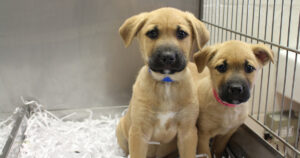 Adopting a pet is an exciting time for you and your family. However, it can be very overwhelming before your new furry friend comes home. Today, we will be discussing what you should do before your new pet comes to their forever home.
Adopting a pet is an exciting time for you and your family. However, it can be very overwhelming before your new furry friend comes home. Today, we will be discussing what you should do before your new pet comes to their forever home.
First, you should consider your current family. Do you have any other pets? How will they react to bringing in a new pet into the home? You also need to consider how your current home will serve for your new pet. Will your social life or work obligations affect your ability to care for this new pet? How do the other people you live with feel about having a new pet in the house? Are there any health issues that need to be accommodated? What kind of lifestyle do you want to live with your new pet? Are you looking for a dog to go running with or a cat to chill with? Are you in the position to train a pet with behavior issues or are you looking for a more relaxed pet experience? All these questions serve as a guide as to what kind, if any, pet you should adopt. If your current life is not suitable for a pet, maybe it’d be best to wait some time to where you will be more prepared to give your new pet the life they deserve.
More likely than not, the adopting agency will charge a fee to help mediate the costs of taking in unwanted or lost animals. This adoption fee will be a tiny fraction of money compared to how much money you will be spending over the life of your pet. You may also need to pay for your pet to be spayed or neutered before bringing them home. Some mandatory expenses of caring for a pet include food, veterinary care, licensing, collars/leashes/ID tags, cat litter, and grooming supplies. Other expenses that are highly recommended but not mandatory are permanent identification in the form of microchipping, training classes, professional grooming, spare supplies, beds, toys, crates, or carriers. There is also the chance that your furry friend will need emergency veterinary care which can get quite pricy. Before adopting a pet, it is important to make sure that you have the right financial state to be able to care and provide for your pet.
Before bringing your new pet home, you need to make sure that you will have the time to spend on taking care of your pet. Pets need to be fed two to three times a day. A pet parent should spend at least one hour per day giving direct attention to your pet in the form of training, exercising, grooming, or playing with them. A pet with a lot of energy will need more time to exercise and play with toys. Pets with long coats will need twenty minutes per day of grooming to keep their coat silky and not matted. Pets with medical conditions will also need extra attention. In the beginning of your adopted pet being home, they may need additional bonding and reassurance time in the first few weeks.
If you are completely prepared to give your pet the best life possible, the last thing you will need to supply are the necessary items for pet care. For dogs, these are food and water bowls, food, collars, leashes, ID tags, a bed, shampoo, nail clippers, brush/comb, poop baggies, toys, treats, and first aid supplies. For cats, they will need food and water bowls, food, kitty litter, collars, ID tag, carrier, nail clippers, brush/comb, toys, and first aid supplies. It could be best, however, to wait to see the size of your new pet for some of these items, as they will vary based on how big or small your new friend is.
Adopting a pet is an enjoyable yet stressful time in one’s life. Hopefully this list of preparation has made you feel more relaxed and prepared to bring your furry friend home. As always, feel free to contact Dr. Olsen at Olsen Veterinary Clinic at 618-656-5868 with any questions.
What Nutrients Does My Cat Need?
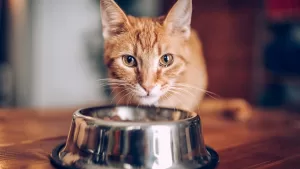 It can be hard to determine what nutrients you cat needs. There are so many options, and it can be very overwhelming. Each option says you need something different. What is the easiest way to give your cat all of the nutrients it needs?
It can be hard to determine what nutrients you cat needs. There are so many options, and it can be very overwhelming. Each option says you need something different. What is the easiest way to give your cat all of the nutrients it needs?
The simplest way is to make sure that your cat is being fed foods that have an Association of American Feed Control Officials (AAFCO) statement of nutritional adequacy on their labels. It could be something like the sentence, “Animal feeding tests using AAFCO procedures substantiate that Yummy Cat Food provides complete and balanced nutrition for adult maintenance, growth and reproduction, or all life stages” or “Yummy Cat Food is formulated to meet the nutritional levels established by the AAFCO Cat Food Nutrient Profiles for adult maintenance, growth and reproduction, or all life stages”.
Essentially, the AAFCO looks for the proper amounts of each nutrient to keep your cat happy and healthy. These nutrients involve lots of protein as cats are carnivores after all. Protein provides energy, maintain muscle, skin, fur, nails, etc. Cats need animal proteins because their bodies need the nutrients it provides. When a cat eats protein, their digestive tract breaks it down into amino acids, which are then reassembled into the type of protein that the cat needs at that time. Animal protein can be expensive, so some cat food manufacturers keep costs low by including only the minimum amount of protein that cats require to survive, not more to help them thrive. A cats crude protein level should be included in the guaranteed analysis section on the label. To bee nutritionally complete and balanced, AAFCO mandates that a cat food for adult maintenance contain a cat food for adult maintenance contain a minimum of 26% crude protein on a dry matter basis. The minimum for growth and reproduction is 30%.
Another important energy source for cats is fat. Fat and the related fatty acids are parts of ingredients like salmon, chicken, liver, or beef. Sometimes, extra fat is added to foods in the forms of beef fat, fish oil, or soybean oil. The AAFCO minimum for fat in all cat foods is 9% on a dry matter basis. Significantly higher levels of fat may be appropriate for cats who are highly active or have trouble maintaining their weight. Diets designed for weight loss will usually contain less fat in comparison to other foods.
Carbohydrates are less important for cats than they are for humans. A diet containing large amounts of carbohydrates is not natural for cats and may promote weight gain and related health problems. Ideally cats should get less than 10% of their calories from carbohydrates.
Vitamins are necessary in a cat’s diet. Sources include animal tissues, vegetables, fruits, vegetable oils, seeds, and grains. However, it is almost impossible to provide all the vitamins a cat needs at the right levels without including a vitamin supplement in the manufacturing process. If a cat is healthy and eating a nutritionally complete diet, additional vitamin supplementation is not necessary and can be dangerous in some cases. Be sure to discuss with your vet if you think your cat needs supplementation. Related, minerals are another important part of your cat’s diet to help your cat’s body function. Some of the minerals that cats need can come from animal and plant-based ingredients (bone meal, for example), but to be nutritionally complete and balanced, cat food manufacturers almost always must add mineral supplements to their formulas. As long as your cat is healthy and eating a good quality food, you shouldn’t have to add any additional supplementation.
The most important nutrient for cats is water. Water is essential for almost every one of your cat’s metabolic functions. Cats will typically let themselves get dehydrated before they seek out water, so water is necessary in their foods. Some ingredients, like whole meats, are rich in water. Water is also added to commercial cat foods as part of the manufacturing process to facilitate mixing. You may see this on the ingredient list as “water sufficient for processing.” Most of the water is subsequently driven out of dry foods to make them more shelf stable. Generally, cats need about 4 to 5 ounces of water per 5 pounds of body weight, but this includes both water from food and water bowls. Cats who eat canned food may only need to drink very little supplemental water.
If you are feeding your cat a good quality food, your cat is getting its essential vitamins and nutrients. To be even more certain, you can look for an AAFCO certification. As always, if you have any questions, feel free to contact Dr. Olsen at Olsen Veterinary Clinic, 618-656-5868.
Dr. Olsen’s Breed Spotlight: The Irish Wolfhound
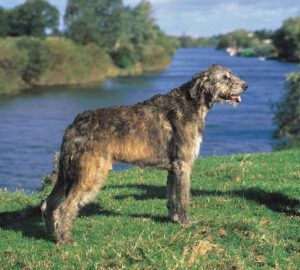 For this next breed spotlight, I will be introducing you to the Irish wolfhound, likely for the first time. This dog is calm, dignified, and the tallest breed of dog (sorry Great Danes). Early ancestors of Irish wolfhounds were fearless, big-game hunters who could dispatch a wolf in single combat. Today, they are the most serene and agreeable of companions.
For this next breed spotlight, I will be introducing you to the Irish wolfhound, likely for the first time. This dog is calm, dignified, and the tallest breed of dog (sorry Great Danes). Early ancestors of Irish wolfhounds were fearless, big-game hunters who could dispatch a wolf in single combat. Today, they are the most serene and agreeable of companions.
The amiable Irish Wolfhound is an immense and muscular hound. They are built along classic Greyhound lines, capable of great speeds at a gallop. A male might stand nearly three feet at the shoulder and can weigh up to 180 pounds. Females will run smaller but are still a very large dog. They have a rough and hard coat that can come in many colors. They can be white, gray, brindle, red, black, and fawn. Irish wolfhounds are way too serene to be fierce guard dogs, but the mere sight of the size of these dogs are enough to deter intruders. Irish wolfhounds are characteristically patient with kids, but their size does require supervision when they are around small children.
The history of this wolfhound goes back to the breeding of indigenous large dogs of Britain to the Middle Eastern coursing hounds that were bartered around the known world in the earliest days of international trade. By the time the Roman Empire had gained a toehold in the British Isles, the giant hounds of Ireland were already long established. In the year 391, the Roman consul received a gift of seven of these hounds that “all Rome viewed with wonder”. These majestic hunters, whose motto was “gentle when stroked, fierce when provoked”, were used on such quarry as the now-extinct Irish elk, a massive, ferocious beast said to stand six feet at the shoulder. In 15th-century Ireland, wolves were overrunning the countryside. The Irish hounds, already renowned big-game hunters, began to specialize on wolves. By the late 1700s, when wolves and other big-game animals of Ireland were hunted to extinctions, Irish wolfhounds lost their job and nearly went extinct themselves. This is a case of a breed doing its job too well for its own good. In 1862, British army captain George Augustus Graham began scouring the country for remaining specimens of Ireland’s national hound. Graham made it his life’s work to protect, standardize, and promote the breed. Today, his name is still spoken with reverence wherever Irish wolfhound fanciers gather.
The coats of Irish wolfhounds have two layers; the outer being harsh and wiry with the under being very soft. They shed throughout the year, but not in an excessive amount. Unlike many other double-coated breeds, Irish wolfhounds don’t “blow out” their coats during an annual or semi-annual shedding season. Irish wolfhounds retain a strong instinct to hunt and chase prey, so they should only be allowed off the leash in areas that are securely fenced. As adults, Irish wolfhounds can become couch potatoes if allowed to, but regular exercise like long walks and play sessions help keep them physically and mentally healthy. A home with a large, fenced area is necessary to provide the environment needed for this breed to thrive. The breed can also exercise mind and body by participating in canine sports like tracking, agility, and lure coursing.
These gentle giants are sure are a breed with a rich history. Their ancestors’ traits reveal themselves with their passion for hunting and need for mental and physical exercise. Generally, these dogs make excellent companions for anyone with enough land to satisfy their need to run. With any questions, please feel free to contact Dr. Olsen at 618-656-5868.
Cat Adoption Checklist
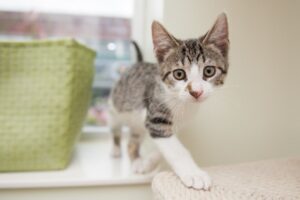 After deciding to adopt a cat, there is plenty to be done. It can seem overwhelming, but hopefully this quick checklist will provide you with information on how to best prepare for your new furry friend.
After deciding to adopt a cat, there is plenty to be done. It can seem overwhelming, but hopefully this quick checklist will provide you with information on how to best prepare for your new furry friend.
Prepare a cat room or area.
One of the most important things your cat needs is a quiet, cozy, and secluded space that your cat can consider their own. It can be a spare bedroom or a corner of your living room. This will make sure your cat becomes familiar with their space before exploring the rest of their home.
Remove any hazards.
Look for strangle hazards such as the cords to blinds, tassels, and drapes. Cats are notoriously curious, so they will play with anything they can find. Similarly, make sure any other hazards like cords, rubber bands, or other small items are not accessible to your cat. Hide any chemicals so your cat is not tempted to drink or lick them. Lastly, remove any toxic plants.
Provide access to a high spot.
Buy having a high spot, cats can view their surroundings with ease. A simple cardboard box in a high place will do the trick but you can buy fancier products. One example is a cat hammock that attaches to your window with suction cups.
Provide your cat plenty of hiding spots.
All cats enjoy hiding places. This can be in a cardboard box, under furniture, or even a cat tree. Do not be alarmed if your cat hides for most of the day when you first bring them home. Just make sure they are eating, drinking, and defecating regularly and give them time to adjust to their new home.
Buy cat products.
This involves a food bowl, water bowl, cat food, a soft bed, a litter box, cat litter, a scratching post, a brush, a cat carrier, and stimulating cat toys.
When adopting a cat, the prep work can seem overwhelming. Hopefully this checklist provided some clarity on what you can do to provide the best home for your new furry friend. As always, feel free to contact Dr. Olsen with any questions at 618-656-5868.
The 4 Best Gifts for Your Dog, Dog Owners, and Dog Lovers
 As the holidays approach rapidly, that means it is time for gift giving! It can be easy to forget your pup in the chaos of the holidays, but here are 4 ideas so your pup doesn’t get forgotten.
As the holidays approach rapidly, that means it is time for gift giving! It can be easy to forget your pup in the chaos of the holidays, but here are 4 ideas so your pup doesn’t get forgotten.
A Matching Bandanna and Mask Set
This ensures that you and your pup hit the town in style and safely! There are many options available online at places such as Etsy that allow you to support small businesses and get a handmade gift for your favorite dog or dog owner. Here are some of my favorites:
Holiday Matching Mask and Dog Bandanna Set, Red and Black Flannel Mask, Bandanna, and Scrunchie Set, and Happy Snowman Bandanna and Face Mask Set
A Treat Toy
Intended to mimic the experience of hunting prey, these types of toys wobble around while your dog paws at it. It rocks back and forth, and your pup will be obsessed with the magic dispenser that they can’t predict or conquer. Here is an example: The Game Dog Toy. Other options for similar products are Snuffle Mats. They allow dogs to find dry food or treats that you’ve hidden. It is a stimulating activity that dogs love. It also serves as a way to extend food and playtime for your pup every day. This Snuffle Mat has great reviews, is easy to fill, and machine washable.PAW5 Wooly Snuffle Mat
Barkbox Subscription
This company ships out a box either once a month or every three, six, or twelve months that give your dog themed and customized treats and toys! My dog at home LOVES the treats and toys that come to our door and it makes Barkbox day her favorite day of the month! Completely customizable with great customer service, Barkbox is a gift that every dog will appreciate. Get one here: Barkbox Subscription
A New Leash and Collar Set
Every dog and dog owner appreciates a new leash and collar that gets worn and used daily. They also allow the owner and dog to express themselves to every other pet and human! You can get fun colored ones like this or even customized ones like this! Also important are holders for their leashes! Here is a cool handmade one!
